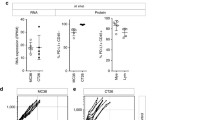Abstract
The co-inhibitory molecule PD-1 suppresses T cell responses and has been targeted in the treatment of cancer. Here, we examined the role of PD-1 in regulating the balance between regulatory and effector T cells and whether blocking PD-1 could enhance tumour vaccine-induced protective immunity. A significantly higher proportion of tumour-resident T cells expressed PD-1 and Foxp3 compared with T cells in the tumour circulation or draining lymph nodes, and this correlated with a lower frequency of IFN-γ- and TNF-secreting CD8 T cells. Blocking PD-1 with a specific antibody reduced Foxp3+ regulatory T (Treg) cell induction and enhanced proliferation, cytokine production, and tumour killing by CD8 T cells. Treatment of CT26 tumour-bearing mice with anti-PD-1 in combination with a vaccine, comprising heat-shocked irradiated tumour cells and a TLR 7/8 agonist, significantly reduced tumour growth and enhanced survival. Furthermore, surviving mice resisted tumour re-challenge. The rejection of tumours in mice treated with the anti-PD-1 vaccine combination was associated with a reduction in tumour-infiltrating Treg cells and enhancement of IFN-γ-secreting CD8 T cells. Our findings demonstrate that high PD-1 expression correlates with increased tumour-infiltrating Treg cells and reduced effector T cells and that when combined with a potent antigen-adjuvant combination, blocking PD-1 effectively enhances anti-tumour immunity.






Similar content being viewed by others
Abbreviations
- BFA:
-
Brefeldin A
- CTV:
-
CellTrace Violet
- dLN:
-
Draining lymph nodes
- hs:
-
Heat-shocked
- irr:
-
γ-Irradiated
- RA:
-
Retinoic acid
- Treg cells:
-
Regulatory T cells
References
Tjin EP, Krebbers G, Meijlink KJ et al (2014) Immune-escape markers in relation to clinical outcome of advanced melanoma patients following immunotherapy. Cancer Immunol Res 2:538–546
Dudley ME, Yang JC, Sherry R et al (2008) Adoptive cell therapy for patients with metastatic melanoma: evaluation of intensive myeloablative chemoradiation preparative regimens. J Clin Oncol 26:5233–5239
Butt AQ, Mills KH (2014) Immunosuppressive networks and checkpoints controlling antitumor immunity and their blockade in the development of cancer immunotherapeutics and vaccines. Oncogene 33:4623–4631
Zou W (2006) Regulatory T cells, tumour immunity and immunotherapy. Nat Rev Immunol 6:295–307
Curiel TJ, Coukos G, Zou L et al (2004) Specific recruitment of regulatory T cells in ovarian carcinoma fosters immune privilege and predicts reduced survival. Nat Med 10:942–949
van der Burg SH, Arens R, Ossendorp F, van Hall T, Melief CJ (2016) Vaccines for established cancer: overcoming the challenges posed by immune evasion. Nat Rev Cancer 16:219–233
Chen W, Jin W, Hardegen N, Lei KJ, Li L, Marinos N, McGrady G, Wahl SM (2003) Conversion of peripheral CD4+ CD25- naive T cells to CD4+ CD25+ regulatory T cells by TGF-beta induction of transcription factor Foxp3. J Exp Med 198:1875–1886
Galvin KC, Dyck L, Marshall NA, Stefanska AM, Walsh KP, Moran B, Higgins SC, Dungan LS, Mills KH (2013) Blocking retinoic acid receptor-alpha enhances the efficacy of a dendritic cell vaccine against tumours by suppressing the induction of regulatory T cells. Cancer Immunol Immunother 62:1273–1282
Conroy H, Galvin KC, Higgins SC, Mills KH (2012) Gene silencing of TGF-beta1 enhances antitumor immunity induced with a dendritic cell vaccine by reducing tumor-associated regulatory T cells. Cancer Immunol Immunother 61:425–431
Jarnicki AG, Lysaght J, Todryk S, Mills KH (2006) Suppression of antitumor immunity by IL-10 and TGF-beta-producing T cells infiltrating the growing tumor: influence of tumor environment on the induction of CD4+ and CD8+ regulatory T cells. J Immunol 177:896–904
Pardoll DM (2012) The blockade of immune checkpoints in cancer immunotherapy. Nat Rev Cancer 12:252–264
Wherry EJ, Kurachi M (2015) Molecular and cellular insights into T cell exhaustion. Nat Rev Immunol 15:486–499
Freeman GJ, Long AJ, Iwai Y et al (2000) Engagement of the PD-1 immunoinhibitory receptor by a novel B7 family member leads to negative regulation of lymphocyte activation. J Exp Med 192:1027–1034
Latchman Y, Wood CR, Chernova T et al (2001) PD-L2 is a second ligand for PD-1 and inhibits T cell activation. Nat Immunol 2:261–268
Okazaki T, Chikuma S, Iwai Y, Fagarasan S, Honjo T (2013) A rheostat for immune responses: the unique properties of PD-1 and their advantages for clinical application. Nat Immunol 14:1212–1218
Kataoka K, Shiraishi Y, Takeda Y et al (2016) Aberrant PD-L1 expression through 3′-UTR disruption in multiple cancers. Nature 534:402–406
Callahan MK, Postow MA, Wolchok JD (2016) Targeting T Cell Co-receptors for cancer therapy. Immunity 44:1069–1078
Sidaway P (2016) Bladder cancer: Atezolizumab effective against advanced-stage disease. Nat Rev Urol 13:238
Larkin J, Chiarion-Sileni V, Gonzalez R et al (2015) Combined nivolumab and ipilimumab or monotherapy in untreated melanoma. N Engl J Med 373:23–34
Wang L, Pino-Lagos K, de Vries VC, Guleria I, Sayegh MH, Noelle RJ (2008) Programmed death 1 ligand signaling regulates the generation of adaptive Foxp3+ CD4+ regulatory T cells. Proc Natl Acad Sci USA 105:9331–9336
Francisco LM, Salinas VH, Brown KE, Vanguri VK, Freeman GJ, Kuchroo VK, Sharpe AH (2009) PD-L1 regulates the development, maintenance, and function of induced regulatory T cells. J Exp Med 206:3015–3029
Wei J, Duramad O, Perng OA, Reiner SL, Liu YJ, Qin FX (2007) Antagonistic nature of T helper 1/2 developmental programs in opposing peripheral induction of Foxp3+ regulatory T cells. Proc Natl Acad Sci USA 104:18169–18174
Acknowledgments
This work was supported by a Science Foundation Ireland Principal investigator Grant (#11/PI/1036) to Kingston H. G. Mills.
Author information
Authors and Affiliations
Corresponding author
Ethics declarations
Conflict of interest
Kingston H. G. Mills is a co-founder and shareholder in Opsona Therapeutics Ltd and TriMod Therapeutics Ltd, university spin-out companies involved in the development of immunotherapeutics. All other authors do not have any conflict of interest.
Rights and permissions
About this article
Cite this article
Dyck, L., Wilk, M.M., Raverdeau, M. et al. Anti-PD-1 inhibits Foxp3+ Treg cell conversion and unleashes intratumoural effector T cells thereby enhancing the efficacy of a cancer vaccine in a mouse model. Cancer Immunol Immunother 65, 1491–1498 (2016). https://doi.org/10.1007/s00262-016-1906-6
Received:
Accepted:
Published:
Issue Date:
DOI: https://doi.org/10.1007/s00262-016-1906-6




